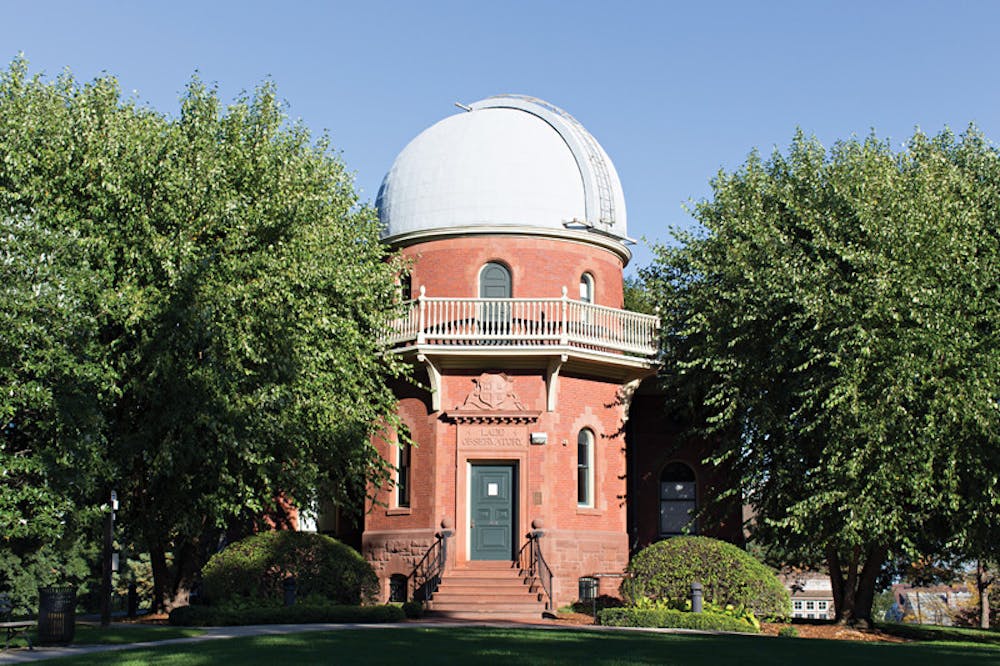Since its creation in 2010, the astronomy concentration has had no concentrators, despite healthy interest in both astronomy courses and the related concentration of astrophysics.
Astronomy offers an A.B. degree and requires 11 to 12 courses, while astrophysics leads to an Sc.B. and requires 18 courses. Several physics professors and astrophysics concentrators cited this difference as the main reason for the lack of astronomy concentrators. Sc.B. programs enable students to study the subject in greater depth, and they better prepare students to pursue science in graduate school, they said.
“If you have the astrophysics Sc.B., there will be a greater number of (graduate) programs that will be available to you,” said James Valles, professor of physics and chair of the department.
There are few other differences between the two concentrations — both are offered through the physics department, and all the courses required for astronomy concentrators are also required for astrophysics.
“I knew I wanted an Sc.B. because I knew I wanted to do physics and do physics grad school,” said Chris Bonnadonna ’15, an astrophysics concentrator.
“At first, I just thought of astronomy, because when I was reading Brown Focal Point … I saw astronomy as the listed one,” said Jahmour Givans ’16. But after talking to the physics concentration advisor, Professor of Physics Robert Pelcovits, Givans said he decided astrophysics would give him a stronger foundation in physics. It would also be “much easier to get into graduate school” with an Sc.B., Givans added, though he is not sure whether he will pursue graduate studies in astrophysics.
Astronomy concentrators interested in obtaining a Ph.D. in the field would most likely have to complete additional courses after graduation in order to be eligible for a doctoral program, said Professor of Physics Ian Dell’Antonio, adding that there are master’s degree programs intended as “stepping stones” for such students.
Despite being billed on Brown’s Focal Point website as “one of the oldest continuously taught subjects in the Brown curriculum,” astronomy is actually a fairly new concentration, created in 2010. Before that, students were able to take astronomy courses through the physics department, and a few pursued independent concentrations in astronomy, Dell’Antonio said.
“We decided to make (astronomy) a formal concentration because we had a few students inquire about it,” he said. But the astrophysics track was also introduced at the same time and has been more popular, he added. In the class of 2012, there was one astrophysics concentrator, and that number has increased to six in the class of 2016.
Despite its unpopularity, keeping the astronomy concentration is worthwhile, multiple physics professors said. “The astronomy A.B. was introduced particularly for students who were not sure they wanted to go on to graduate study, and even more specifically for students who decided they wanted to study astronomy in their second year,” Dell’Antonio said, adding that astrophysics “is a very hard degree to complete” if embarked upon after students’ first year at Brown.
Sam Dallas ’16, an astrophysics concentrator, said she felt like she was “playing catch-up” because she did not decide to take physics until the second semester of her first year.
Brown draws students “who are questioning and are open to lots of ideas, who haven’t necessarily made up their minds at the time that they apply” and professors “encourage students to experiment,” said David Targan, associate dean of science education and adjunt associate professor of physics. It is important that they have the opportunity to enter this area in an A.B. program even after their first year, he added.
The A.B. would also be a good option for students who wanted to double-concentrate, Dell’Antonio, Valles and Targan all said.
Despite limited options for graduate school, “there are lots of other possibilities” for astronomy concentrators, Targan said. “They could teach science, they could use that sort of knowledge of scientific methods, in a whole variety of career options.”
Employers “like people who have learned how to solve problems in a certain way, think about problems in a certain way, that have the quantitative skills they could throw at solving problems,” and astronomy concentrators will have all these skills, Valles said.
For now, the physics department has no plans to change or get rid of the concentration. “When it was introduced, it was introduced with the idea that we would revisit that choice. At the moment, I think the pressure is to keep it because the conditions that would lead students to want to do an A.B. starting late, rather than an Sc.B., are still there,” Dell’Antonio said.
“What’s really important is that we have the advisers in place for people that want to do it,” Valles said. “It’s not some orphaned concentration.”
“I think it’s good that it exists as an option, and there’s no reason not to have it as an option,” said astrophysics concentrator Scott Underriner ’15. “But I don’t think there would be many voices crying out in protest if for some reason it were canceled.”

ADVERTISEMENT




